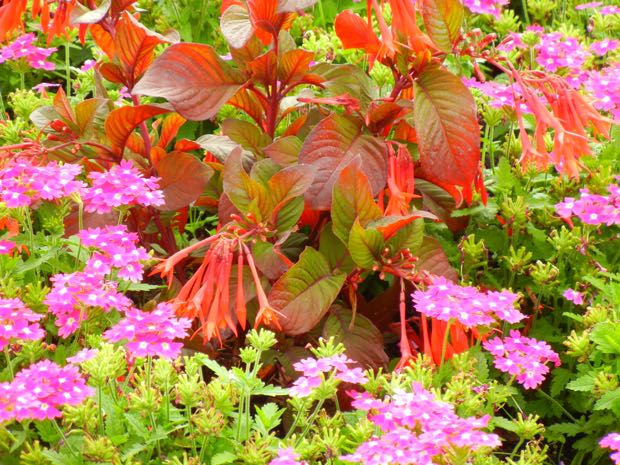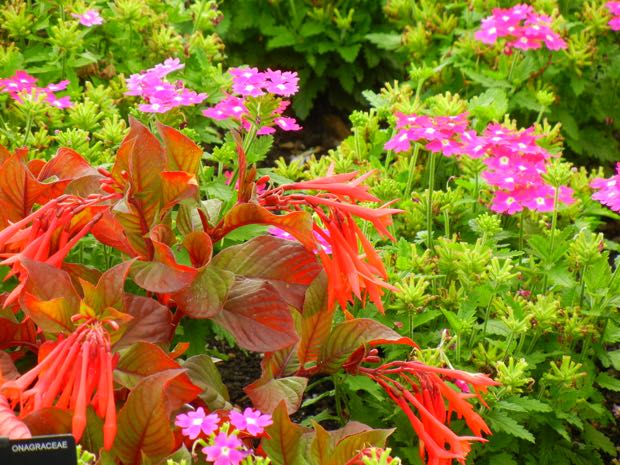Fuchsia triphylla ‘Thalia’ also known as Fuchsia ‘Thalia,’ is a delightful upright shrub that adds a touch of vibrant color to any garden. With its bronze leaves and eye-catching orange-red clusters of flowers, it is a captivating addition to your outdoor space. It is part of the Onagraceae family of plants.
This fuchsia variety has a relatively compact size, typically reaching a height of about 3 feet (90cm). While it may be considered a slow grower, its growth rate is compensated by its robust and bushy nature. If you desire a fuller and more abundant display, you can opt to plant two or three specimens in a pot during early spring. By pinching the tip of each plant early on, you can encourage bushier growth, which will result in a more luxurious appearance.
Once established, Fuchsia triphylla ‘Thalia’ rewards you with a profusion of flowers from spring to autumn. It takes approximately 12 weeks from the time of pinching for the plant to produce its beautiful blossoms. The flowers typically appear in clusters, creating a captivating display of colors. This fuchsia variety is known for attracting hummingbirds with its long, tubular flowers, adding an element of enchantment to your garden as these tiny birds flit among the blooms.

How to grow Fuchsia triphylla ‘Thalia’:
When it comes to its preferred growing conditions, Fuchsia triphylla ‘Thalia’ thrives in sunny locations. It delights in basking in the warmth and radiance of the sun’s rays. However, it is essential to note that this plant is sensitive to frost and cold temperatures. In colder climates, it is recommended to cut it back significantly low or grow it in greenhouses or as a houseplant during the winter months to protect it from harsh conditions.
To ensure the optimal growth of Fuchsia triphylla ‘Thalia,’ it requires moist, well-drained soil. Adequate watering is crucial, especially during dry spells, to keep the soil consistently moist but not waterlogged. This fuchsia variety also tolerates partial shade, allowing you some flexibility in choosing the ideal location for its placement in your garden.
Fuchsia triphylla ‘Thalia’ exhibits good resistance to common pests and diseases. However, like any plant, it is important to remain vigilant and monitor for any signs of issues. Regularly inspect the leaves and stems for pests such as aphids or whiteflies. If detected, these pests can be controlled through organic methods like insecticidal soap or by introducing beneficial insects like ladybugs.
Propagating:
Propagation of Fuchsia triphylla ‘Thalia’ can be accomplished through various methods, including stem cuttings and seed sowing. Stem cuttings are a popular and reliable way to propagate this fuchsia variety. Take cuttings from healthy, established plants during the growing season. Choose non-flowering shoots and trim them to around 4-6 inches in length. Remove the lower leaves and dip the cut end in a rooting hormone to enhance root development. Plant the cuttings in a well-draining soil mix and keep them consistently moist. With proper care and warmth, the cuttings will root and develop into new plants.
Seeds can also be used for propagation. Collect ripe seeds from mature fruits and sow them in a seed-starting mix. Keep the soil moist and provide warmth and light. Germination may take several weeks, and the resulting seedlings will require gradual acclimatization to outdoor conditions before transplanting into the garden.
To promote healthy growth and abundant flowering, regular maintenance practices are beneficial. Pruning can be done in early spring to remove any dead or damaged branches and to shape the plant. Pinching the tips of young plants early on encourages branching and a bushier growth habit. Deadheading faded flowers throughout the blooming season can help divert the plant’s energy toward producing new blooms.
Outdoors and Indoors:
Fuchsia triphylla ‘Thalia’ is not only suitable for outdoor gardens but can also be grown as a houseplant or in containers. When grown in containers, choose a well-draining potting mix and ensure proper drainage to prevent waterlogging. Providing a balanced fertilizer every few weeks during the growing season will help nourish the plant and promote vigorous growth and abundant flowering.
Fuchsia triphylla ‘Thalia’ is considered a tender perennial. In regions with cold winters, it may not survive freezing temperatures. If you live in such an area, you can either bring the plant indoors during the colder months or treat it as an annual and replant it each year.
By considering these aspects of care, propagation, and disease resistance, you can enjoy the beauty and splendor of Fuchsia triphylla ‘Thalia’ while ensuring its health and longevity in your garden or as a cherished houseplant.
With its vibrant and alluring presence, Fuchsia triphylla ‘Thalia’ can elevate the visual appeal of your garden or patio. Whether planted in containers, hanging baskets, or flower beds, its radiant bronze foliage and stunning orange-red flowers make it a captivating focal point. Enjoy the enchantment of this fuchsia variety as it adds a burst of color and attracts hummingbirds, bringing life and beauty to your outdoor space throughout the blooming season.
You might also like reading about Fuchsia magellanica.




